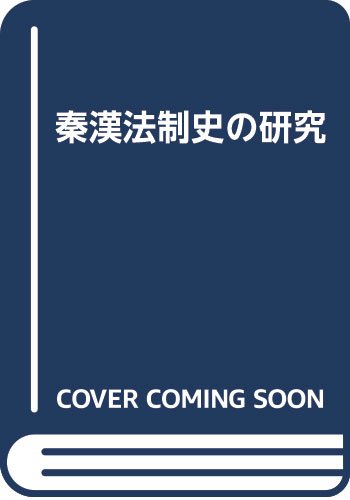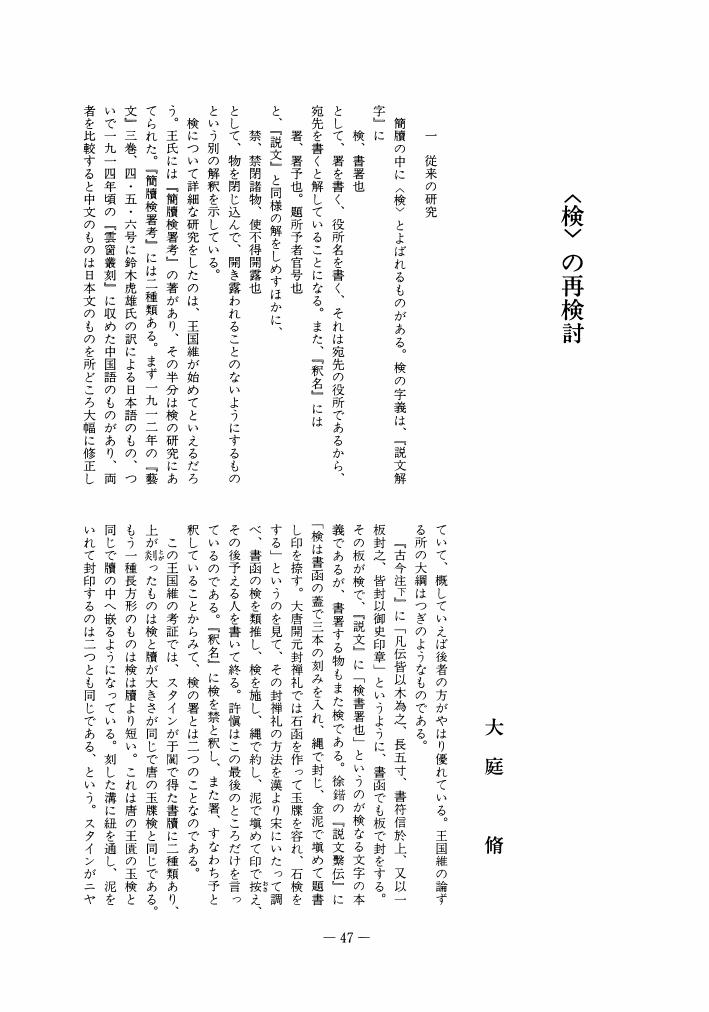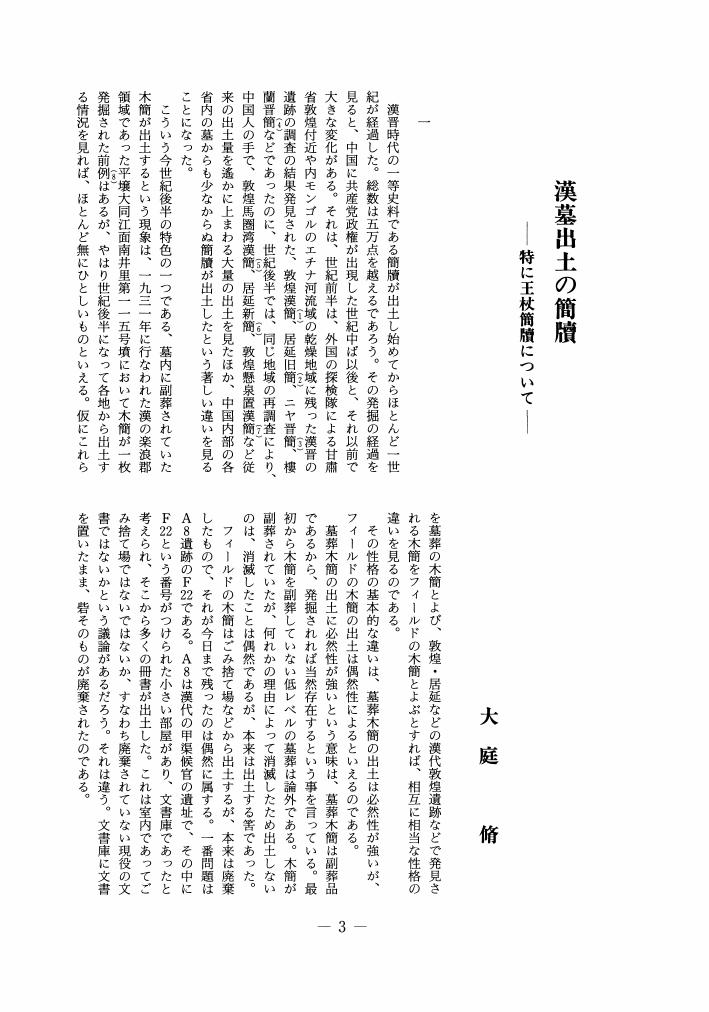3 0 0 0 OA 徳川吉宗と大清会典
- 著者
- 大庭 脩
- 出版者
- Japan Legal History Association
- 雑誌
- 法制史研究 (ISSN:04412508)
- 巻号頁・発行日
- vol.1971, no.21, pp.61-95,V, 1972-03-30 (Released:2009-11-16)
Soon after Tokugawa Yoshimune (_??__??__??__??_) acceded to Shogunate on 1st year of Kyoho (_??__??_), 1716, he began to be much interested in the study of law and collected rare books of Japanese classical codes.On the other hand, he collected chinese books. First, he gave permission to the import of some kind of prohibited books on christianity-the books of technology and natural sciences written by those Cathoric priests who came to China at the last stage of Ming (_??_) dynasty. He then bought many Chinese books of code and geography. Among these Chinese codes, he had the most interest in Ta-ch'ing-Hui-tien(_??__??__??__??_) The first copy in Japan of Ta-ch'ing-Hui-tien was brought into Nagasaki (_??__??_) in 5th year of Kyoho, and he bought it. He further ordered Chinese merchants to bring one more copy, and he got it two years later. He ordered Fukami Kyûdai-u (_??__??__??__??__??_) to translate Ta-ch'ing-Hui-tien into Japanese. Kyûdai-u was the son of Fukami Gentai (_??__??__??__??_), and was Yoriai Jusha (_??__??__??__??_) like his father Gentai. Gentai's grandfather was a Chinese named Ko-ju-Kaku (_??__??__??_ Kas-shou-chiao), and Gentai had worked at Nagasaki as an interpreter. He could speak good Chinese.Kyudai-u went to Nagasaki with the firstly imported copy and began to translate it, asking about the difficult passages to those recently arrived Chinese merchants there. He stayed at Nagasaki from December of 6th to Feburary of 12th year of Kyoho.During these years, while engaged in the translation, he helped Yoshimune to buy useful Chinese books, and helped to get from a Chinese answers to those questions about China which was given by Ogi-u Hokkei (_??__??__??__??_ or Soshichi _??__??_) at the command of Yoshimune. Shin cho tan ji (_??__??__??__??_) by Shu hai sho (_??__??__??_Zhû-pei-zhang) is one of records of those questions and answers. The Chinese who answered Kyudai-u's questions concerning Ta-ch'ing-Hui-tien was Son ho-sai (Sun Fu Zhai _??__??__??_). We can prove the fact by his application for a license of trade, which is recorded in Wakan kibun (_??__??__??__??_). He applied for a license of trade for the reason that he liked to get a Chinese specialist about laws and official service to understand the discription in Ta-ch'ing-Hui-tien, for he could not illustrate some particular parts of the book, because he was a merchant and had no experiance as a government official. He left Nagasaki in November of 11th, and came back from China in December of 12th of Kyoho with Sin sho-an (Chèn Xié an _??__??__??_).Sin sho-an, with his name (_??_) Bing (_??_), another name (_??_) Dèng wei (_??__??_) (Syoan itself being his pen-name (_??_)), had domicile in Hang chou(_??__??_). and stayed at Nagasaki until 16th of Kyoho with Son-ho-sai.On 15th year of Kyoho, Yoshimune ordered Sin sho an to correct any possible mistake in Ogiu Hokkei's (_??__??__??__??_) revised copy of Táng lü-su-i (_??__??__??__??_) which done in 10th of Kyoho. Sin pointed out some words and phrases to be corrected and gave in the margin of Ogiu's book his opinion of each of Ogiu's point of mistake just above where the mistake was seen, and further more made a separate note gathering all these adaptations. Ogiu's revised copy and Sin's note are both kept in the library of the Imperial Household Agency.Shin sho an brought back a copy of Táng lü-su-i to China and showed it to L-i ting i (_??__??__??_)who was the Minister of Justice (_??__??__??__??_). And Li-ting-i wrote a preface to this important classical code. At that time, Táng-lü-su-i was very rare in China, perhaps it was impossille to find its complete copy. And on 21th of Kyoho, Sin visited Nagasaki again and brought a copy of Li-ting-i's preface written by his own hand. We can also see it in the same Library of the Imperial Household Agency.
2 0 0 0 徳川吉宗と大清会典:享保時代における日清交渉の一斑
- 著者
- 大庭 脩
- 出版者
- Japan Legal History Association
- 雑誌
- 法制史研究 (ISSN:04412508)
- 巻号頁・発行日
- vol.1971, no.21, pp.61-95,V, 1972
Soon after Tokugawa Yoshimune (_??__??__??__??_) acceded to Shogunate on 1st year of Kyoho (_??__??_), 1716, he began to be much interested in the study of law and collected rare books of Japanese classical codes.<BR>On the other hand, he collected chinese books. First, he gave permission to the import of some kind of prohibited books on christianity-the books of technology and natural sciences written by those Cathoric priests who came to China at the last stage of Ming (_??_) dynasty. He then bought many Chinese books of code and geography. Among these Chinese codes, he had the most interest in Ta-ch'ing-Hui-tien(_??__??__??__??_) The first copy in Japan of Ta-ch'ing-Hui-tien was brought into Nagasaki (_??__??_) in 5th year of Kyoho, and he bought it. He further ordered Chinese merchants to bring one more copy, and he got it two years later. He ordered Fukami Kyûdai-u (_??__??__??__??__??_) to translate Ta-ch'ing-Hui-tien into Japanese. Kyûdai-u was the son of Fukami Gentai (_??__??__??__??_), and was Yoriai Jusha (_??__??__??__??_) like his father Gentai. Gentai's grandfather was a Chinese named Ko-ju-Kaku (_??__??__??_ Kas-shou-chiao), and Gentai had worked at Nagasaki as an interpreter. He could speak good Chinese.<BR>Kyudai-u went to Nagasaki with the firstly imported copy and began to translate it, asking about the difficult passages to those recently arrived Chinese merchants there. He stayed at Nagasaki from December of 6th to Feburary of 12th year of Kyoho.<BR>During these years, while engaged in the translation, he helped Yoshimune to buy useful Chinese books, and helped to get from a Chinese answers to those questions about China which was given by Ogi-u Hokkei (_??__??__??__??_ or Soshichi _??__??_) at the command of Yoshimune. Shin cho tan ji (_??__??__??__??_) by Shu hai sho (_??__??__??_Zhû-pei-zhang) is one of records of those questions and answers. The Chinese who answered Kyudai-u's questions concerning Ta-ch'ing-Hui-tien was Son ho-sai (Sun Fu Zhai _??__??__??_). We can prove the fact by his application for a license of trade, which is recorded in Wakan kibun (_??__??__??__??_). He applied for a license of trade for the reason that he liked to get a Chinese specialist about laws and official service to understand the discription in Ta-ch'ing-Hui-tien, for he could not illustrate some particular parts of the book, because he was a merchant and had no experiance as a government official. He left Nagasaki in November of 11th, and came back from China in December of 12th of Kyoho with Sin sho-an (Chèn Xié an _??__??__??_).<BR>Sin sho-an, with his name (_??_) Bing (_??_), another name (_??_) Dèng wei (_??__??_) (Syoan itself being his pen-name (_??_)), had domicile in Hang chou(_??__??_). and stayed at Nagasaki until 16th of Kyoho with Son-ho-sai.<BR>On 15th year of Kyoho, Yoshimune ordered Sin sho an to correct any possible mistake in Ogiu Hokkei's (_??__??__??__??_) revised copy of Táng lü-su-i (_??__??__??__??_) which done in 10th of Kyoho. Sin pointed out some words and phrases to be corrected and gave in the margin of Ogiu's book his opinion of each of Ogiu's point of mistake just above where the mistake was seen, and further more made a separate note gathering all these adaptations. Ogiu's revised copy and Sin's note are both kept in the library of the Imperial Household Agency.<BR>Shin sho an brought back a copy of Táng lü-su-i to China and showed it to L-i ting i (_??__??__??_)who was the Minister of Justice (_??__??__??__??_). And Li-ting-i wrote a preface to this important classical code. At that time, Táng-lü-su-i was very rare in China, perhaps it was impossille to find its complete copy. And on 21th of Kyoho, Sin visited Nagasaki again and brought a copy of Li-ting-i's preface written by his own hand. We can also see it in the same Library of the Imperial Household Agency.
2 0 0 0 OA 〈検〉の再検討
- 著者
- 大庭 脩
- 出版者
- 書学書道史学会
- 雑誌
- 書学書道史研究 (ISSN:18832784)
- 巻号頁・発行日
- vol.1991, no.1, pp.47-67, 1991-06-30 (Released:2010-02-22)
1 0 0 0 OA 豊臣秀吉を日本国王に封ずる誥命について : わが国に現存する明代の誥勅
- 著者
- 大庭 脩
- 出版者
- 関西大学東西学術研究所
- 雑誌
- 関西大学東西学術研究所紀要 (ISSN:02878151)
- 巻号頁・発行日
- vol.4, pp.29-77, 1971-03-30
1 0 0 0 荻生北溪・徂徠と楽書校閲
- 著者
- 大庭 脩
- 出版者
- 東方学会
- 雑誌
- 東方学 (ISSN:04957199)
- 巻号頁・発行日
- no.91, pp.90-105, 1996-01
1 0 0 0 OA 漢代における功次による昇進について (特集 居延漢簡の研究)
- 著者
- 大庭 脩
- 出版者
- 東洋史研究会
- 雑誌
- 東洋史研究 (ISSN:03869059)
- 巻号頁・発行日
- vol.12, no.3, pp.206-220, 1953-03-31
During the Han period two ways of promotion were open for the Government offcials; merit and long service. The Autobiography of Ssu-ma ch'ien (司馬遷) as well as the Biography of Tung Chung-shu (董仲舒) in the Shih Chi (史記) supply us with materialin this connection, and our Etsin-gol MSS. inform us that "lao (勞)" (long sevice) and "kung (功)" (merit) were the standard for promotion.
1 0 0 0 新出土資料による中国古代医学の研究-張家山出土漢簡を中心に-
私たちは、上記の課題について、哲学・医学・古文字学の三方面から二年かけて研究した。私たち三名の研究者が毎週1回集まって(引書)を読み、その注釈と翻訳を行った。また私たちは2年間に5回の研究発表会を開いた。第1回1993年9月11日京大会館 猪飼祥夫「脈書」と「引書」の性格第2回1993年11月4日京大会館 工藤元男睡虎地泰簡「日書」に現れた治病・鬼神関係資料をめぐって第3回1994年10月22日近つ飛鳥博物館 永田英正 長城守備隊の勤務第4回1994年11月20日京大会館 大形徹 新出土資料より見る鬼と気の問題第5回1995年1月29日京大会館 坂出祥伸 出土医書にみえる自然リズムにもとづく治病・養生 大庭脩 武威早灘坡王杖簡冊の復原 以上の共同研究によって、私たちは以下のような新しい知見を得た。1)張家山出土<引書><脈書>には早くも、天・地の気の運動と人間の身体の気の運動とを同調させれば、長生が獲得できるという考えが説かれている。2)<引書><脈書>には、疾病の原因として、気の流れの不調が挙げられている。しかし、鬼による病因論は、これらの資料には見えない。3)馬王堆漢墓医書と同様に、張家山出土医書も、鍼による治療はまだ記述されていない。それらは灸による治療を記述しているに過ぎない。また、これらの資料には、十二経脈に関する祖型的記述は見えているが、しかし、それらはまだ五臓と関係づけられていない。
1 0 0 0 OA 江戸時代に舶載された法帖の研究
- 著者
- 大庭 脩
- 出版者
- 書学書道史学会
- 雑誌
- 書学書道史研究 (ISSN:18832784)
- 巻号頁・発行日
- vol.1998, no.8, pp.3-27, 1998-09-30 (Released:2010-02-22)
1 0 0 0 OA (書評)森鹿三著「「居延出土の王莽簡」(東方学報京都33)」
- 著者
- 大庭 脩
- 出版者
- 法制史学会
- 雑誌
- 法制史研究 (ISSN:04412508)
- 巻号頁・発行日
- vol.1965, no.15, pp.232-233, 1965-10-10 (Released:2009-11-16)
1 0 0 0 日中関係史上の浙江と日本
- 著者
- 藤善 眞澄 王 宝平 王 勇 内田 慶市 尾崎 實 宮下 三郎 籔田 貫 薗田 香融 大庭 脩 WAN Bao Ping WAN Yong 永井 規男 日下 恒夫
- 出版者
- 関西大学
- 雑誌
- 国際学術研究
- 巻号頁・発行日
- 1993
研究テーマ「佛僧の往来」「江戸時代の日中関係」「漢籍と和書の相互交流」「浙江人の日本留学と中国近代文化」の四分野にわたって例会発表を行い、その一部は東西学術研究所々報等に掲載されている。さらに従来の成果をもとに本年度の調査研究を加味し<浙江と日本>のタイトルで業績発表を行うことが決定されており、すでに以下の論文15篇が提出されている。(1)藤善眞澄「入宋僧と杭州・越州」(2)大庭脩「浙江と日本-1684年より1728年に至る間の寧波船の動向」(3)宮下三郎「李仁山種痘書について」(4)籔田貫「寛政12年 遠灘漂着唐船萬勝号について」(5)松浦章「浙江と倭冦」(6)高橋隆博「浙江の漆芸-螺鈿器と識文漆器をめぐって-」(7)尾崎實「後浪推前浪-浙江人の場合-」(8)内田慶市「ヨーロッパ発〜日本経由〜中国行き-西学東漸のもう一つのみちすじ-」(9)毛紹晢「稲作の東伝と江南ルート」(10)王勇「鑑真渡日の動機について」(11)蕭瑞峰・徐萍飛「浙東の唐詩ルートと日本平安朝の漢詩」(12)屠承先・呉玲「呉越国の文化と日本」(13)王宝平「傅雲龍の日本研究の周辺」(14)呂順長「中国の省による留日学生派遣の事始め」(15)謝志宇「留日浙江人の夏馬尊について」これらは平成8年度中に出版し報告書にかえたい。今年度は王勇の漢籍・和書の調査を中心に置き、藤善眞澄による日中交通路の調査ならびに史蹟、資料の蒐集を併せ実施し、多大の成果を得ることができた。これらは逐次発表を行いつつ、次の目標につなげていきたいと思う。
1 0 0 0 明治期に中国へ流出した日本寺院旧蔵文書に関する総合的研究
本調査研究によって解明された主要な点を上げるならば、次のとおりである。1.明治維新後の日本において、中国人蒐書家によって系統的な典籍の蒐集がなされ、中国本土に移送されていた。ことに清国総領事黎庶昌や清国領事館駐在員であった楊守敬らによって系統的に蒐集されて、中国大陸に移送され、その後、各地を転々とするとともに、日中戦争から国共内線の時期における散逸、焼亡の危機をくぐりぬけて今日に伝来するにいたった各種図書・文献について、その所在を跡づけることができた。2.京都高山寺の寺院文書が、中国武漢の湖北省博物館において所蔵されていることをつきとめた。今回の発見成果の重要なものの一つが、この湖北省博物館所蔵の高山寺文書であった。これも楊守敬蒐集図書の一部をなしている。明治初年の日本社会では廃仏毀釈の嵐が吹き荒れており、寺院の什器や経巻の類が流出して古物市場にあふれていた。高山寺文書の流出も多岐にわたっているが、その一部が楊守敬の購入するところとなり、中国に伝存することとなったのである。3.今回の調査で、日本の仏典が中国各地の所蔵機関に少なからず伝存することを確認し得た。そして同時に次の点が問題であることが判明した。すなわちこれら日本から請来された仏書、写経の類は、中国人の目からは敦煌伝来の仏典と見なされる傾向があるという点である。明白に日本で書写された経巻であるにもかかわらず、それらがしばしば敦煌伝来の写経と混同して所蔵され、また目録上にもそのような配列記載がなされているという問題である。これは日本人研究者の考えの及ばなかった問題でもあり、日中双方の研究者・関係者の協議に基づいて、問題が早急に改善されることが望まれる。
1 0 0 0 OA 漢墓出土の簡牘
- 著者
- 大庭 脩
- 出版者
- 書学書道史学会
- 雑誌
- 書学書道史研究 (ISSN:18832784)
- 巻号頁・発行日
- vol.1996, no.6, pp.3-15, 1996-09-30 (Released:2010-02-22)




